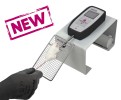Authors
M. J. Barton, J. W. Morley, M. A. Stoodley, S. Shaikh, D. A. Mahns et al.
Lab
School of Medicine, University of Western Sydney, Penrith, Australia
Journal
Journal of Biophotonics
Abstract
Sutures remain the standard peripheral nerve repair technique, whether applied directly or indirectly to nerve tissue. Unfortunately, significant postoperative complications can result, such as inflammation, neuroma formation and foreign body reactions. Photochemical-tissue-bonding, PTB, using rose Bengal, RB, integrated into a chitosan bioadhesive is an alternative nerve repair device that removes the need for sutures. Rats were arranged into three groups: RB-chitosan adhesives-repair, end-to-end epineural suture-repair -surgical standard- and sham laser-irradiated control. Groups were compared through histological assessment, electrophysiological recordings and grip motor strength. RB-chitosan adhesive repaired nerves displayed comparable results when compared to the standard suture-repair based on histological and electrophysiological findings. Functionally, RB-chitosan adhesive was associated with a quicker and more pronounced recovery of grip force when compared to the suture-repair.
BIOSEB Instruments Used:
Grip strength test (BIO-GS3)

 Douleur - Allodynie/Hyperalgésie Thermique
Douleur - Allodynie/Hyperalgésie Thermique Douleur - Spontanée - Déficit de Posture
Douleur - Spontanée - Déficit de Posture Douleur - Allodynie/Hyperalgésie Mécanique
Douleur - Allodynie/Hyperalgésie Mécanique Apprentissage/Mémoire - Attention - Addiction
Apprentissage/Mémoire - Attention - Addiction Physiologie & Recherche Respiratoire
Physiologie & Recherche Respiratoire
 Douleur
Douleur Système Nerveux Central (SNC)
Système Nerveux Central (SNC)  Neurodégénérescence
Neurodégénérescence Système sensoriel
Système sensoriel Système moteur
Système moteur Troubles de l'humeur
Troubles de l'humeur Autres pathologies
Autres pathologies Système musculaire
Système musculaire Articulations
Articulations Métabolisme
Métabolisme Thématiques transversales
Thématiques transversales SFN2024: Venez rencontrer notre équipe sur le stand 876 à Chicago
SFN2024: Venez rencontrer notre équipe sur le stand 876 à Chicago 